An early precursor : The T-32
From the BT-IS to the A20, and then the T32, with the BT SV2 sloped armor (1936), to end with the final T32 five wheels tracks, the blueprint of the T34 was set up far before the war. The very same team which promised Stalin to replace the BT serie with a better "universal tank", lead by engineer Mikhail Koshkin, designed a sloped armored box encasing a powerful diesel V12, less sensitive than high octane petrol engines, both to increase range and avoid the tanks to burst in flames too easily as other BT-5 and BT-7 did during the war against Japan in Mandchouria.In fact, the first prototype of the T34 (An improved t32, with a thickened armor, which achieved succesful field trials at Kubinka, was even more simplified for mass production) was ready as far as the beginning of 1939. URSS was then rearming, and buying time. The first two preseries rolled of KhPZ factory in Kharkov (Ukraine) at the very first month of 1940, under the patronage of Serguei Ordzhonikidze. From april to may they underwent a large array of hard trials, rolling our 2000 km from Kharkov to the Mannhereim line in Finland, and back to the factory via Moskow.
T34, first serie of 1940 :

Medium tanks lineage : BT-7, T32, T34 1940 et T34 1941.
The T34 was largely improved during trials, and mass production was set up in september by Koshkin (which died exhausted) successor, by Alexander Morozov, as chied designer. All previous models, the T-26, the BT and the heavy multi-turreted T28 were all dropped to make room for the new medium tank. Production was also separated, Leningrad furnishes the L11 gun, Kharkov the diesel V12, Moskow the electrical components and the armored hull and final assembly were performed at Stalingrad tractor factory. After july 1941, all the most vulnerable production centers saw a huge delocalisation effort to the east, and Stalingrad only remained untouched until the very end of the battle at the beginning of 1943 and Von Paulus capitulation. But the 1940 was hampered by various deficiencies : The complex hull front armor piece was difficult to manufacture, there was a shortage of V12 diesels, so most of the first 1940 serie tanks were equipped with the BT tank's Mikulin M-17 at Gorky factory, as well as provisional transmission and clutch. The initial L11 76 mm gun was criticized to have a too low muzzle velocity, and the F34 was designed instead at Gorky. It was lately put in production, equipping the first units in july 1941.
The T34/76 : general conception.

The T34 1940, the first mass production model. The 1941 has many differences, mostly turned towards an easier production.
When all designed components were brought together, the new T34 serie was equipped with the final, successful 76,2 mm gun, and was the basis for all the production until 1944 as known as the T34/76, by opposition to the later T34/85. New improved coil-spring Christie suspension were fitted, as well as the V12 diesels and adaptated clutch and transmission. 10-RT 26E radio set was replaced by 9-RS model, and the tracks were slightly enlarged. The frontal armor was simplified for mass production, as well as many other elements. When out in business, the T34 had no equivalents in the world. They were able to combine almost to the perfection the magic triangle (speed versus armor versus armament). The sloped armor was a good solution to deflect most hits while retaining some thickness. First encounters in july 1941 proved that no german tank was then able to score a single hit. To the disappointed officers, their shots simply bounced off these well-armoured machines. The need for a most powerful gun, with very high velocity just started there, as well as the origin for the Panther design (Panzer V). The 34 was equipped with a variety of hatches and turrets during its lifespan, but almost all had their upper hull equipped with railings to allow soviet troops to hang on them, supplying the lack of transports. None was ever equipped with an anti-aircraft mount, and many were lost because of this in 1944 because of the new Stuka antitank conversions (Ju 47 D).
The T34 was the mainstay of the red army throughout these years, from 1941 to the end of 1944 when sufficient numbers of T34/85, a new tank in many aspects, gradually replaced them. The T34 was a real shock for the Germans. They had nothing like it. Sloped armour proved highly effective, despite their relatively low muzzle velocity gun (which was however favourably compared to most Pz III and Pz IV german guns of the time), their diesel was sturdy and able to cope with almost all extreme weather conditions, their wide tracks were perfectly shaped to cope with the "raspoutista" (a sea of mud) in autumn, and the snow in winter. Plus, it was way more easy to produce than all panzer models so far, such that fronline units had inferiority complexes, for many tankists, the T34 was deemed invincible. It was not true of course. A well placed hit between the tracks and wheels still can disable them. And in defence, as in northern africa, the german 88 mm guns just butchered them mercilessly.
Tactics
From the end of 1942, a new version, the 1942 serie, was limited to minor improvements to the crew comfort and vision systems. The 76 mm could fire high explosive rounds as well as armor-piercing ones, which proved fatal to all Panzers but the late heavily protected versions of the Panzer IV. In association with the slower, but impregnable KV1, they performed hundred of "kill teams" as early as july 1941, but german tactics, like in France, proved superior, and both well coordinated stuka and antitank planes as well as 88 mm guns prevented the Russian T34s to overwhelm their defenses at first. During the Moskow winter campaign and later at Stalingrad, the T34 were massively engaged for the first time and overwhelmed german defences. German tanks then were subjected to this icy weather. Wheels rubber peeled off, engines were slow to start and has to be slowly warmed up, machine-guns were often jammed, and mobility was almost impossible as the narrow tracks of the Panzer III and IV caused them to "sink" litteraly in the snow. Plus, bad weather prevented any aerial support, preventing them to any kind of usual wehrmacht tactics. However at the midst of 1943, the new Panther proved lethal at long range against T34, which still had to catch their preys very close so that every of their rounds can pay. These tactics proved decisive at Kursk, when hundred of Panthers and Tigers, while beeing efficient at long range, were overwhelmed by thousands of T34s, stricking from all sides. Just like sherman tanks, two or more T34 were sacrificed in order to allow others to flank their foe, hitting it from their vulnerable rear.Production problems
The 34 was not the "perfect" tank the german has sought however : Poor quality standard assembly, uncaring molting components, and many other deficiencies, combined with overall very harsh running conditions as well as low training skills, sometimes inept commanders, took their toll on every division equipped with T34. In some occurences, more than half of the tanks engaged in combat were lost due to mechanical breakdowns and other teething problems... The Diesels were particularly sensitive to dust and sand. first Filters were proven ineffective. Final assemblies of transmission and clutches often caused serious amount of vibrations and sometimes collapses. It was not unusual to see entire spare transmissions and other mechanical parts stowed everywhere possible, between extra fuel tanks, tarpaulin, shovel, pickaxe, iron cable, and of course spare tracks sections. The usual picture of T34 advancing quickly with entire platoons installed on their hull, was rarely more than a rare occurence, for short range tactics, or even pure propanganda. In fact poor logistics made the T34 resembling, at least at the beginning, as supply armored trucks... Assembly lines, due to the german fast advance were relocated and painfully put to production in harsh conditions (sometimes machine tools were operational before any roof was installed...), at Dzherzhinski Ural Railcar Factory in Nizhny Tagil, and Stalin Tractor Factory in Chelyabinsk ("tankograd"). But until the fall of 1942, the fastest and biggest production was on the eastern part of Stalingrad. T34 were throwned into combat right at the factory door.The T34/76 model 1941
This model B was a good deparure from the previous 1940 model. Almost everything was put in scrutiny for mass production, like the new gun mount, the wielded turret with a new, single, wide hatch, and many other parts. The single hatch was seen for production facility, but it was heavy and easily jammed, trapping everybody inside. In fact its was hatred by the crews (which already had no compfort and poor ergonomy), which quickly dubbed it the "pirozhok" (stuffed bun). The very large rear exhaust covers were another feature, which did not stand for long however. The turret itslef lacked sufficient protection for the commander, with no special-purpose hatch, a traversable periscope, and the single heavy hacth, forward-opening, had a single vision slit, often blurred or dirty. But moreover, the commander was also responsible for loading the gun, due to the four men crew. This was not corrected until the introduction of the three men turret with the T34/85. Later on, many models had additional armor plating like the model 1942 s ekranami ("with plates") to answer to the latest german gun developments. Also, the amour was largely improved compared to the 1940 model (or "model A"). Some 324 T34 model B were rearmed with a special high-velocity 57 mm gun ZiS-4 or ZiS-4M, under the name of T34/57, and used as tank-hunters, notably during the battle of moskow.The T34/76 model 1942 to 1944
As the standardized machine tools used for the T34 were not adaptable with ease, production specifics were limited. Many features of the T34 remains unchanged until 1943, despite the complaints of the crews and their commanders. Even more simpler and cheaper to produce parts and methods were applied, like the automated welding and hardening plates. For example, the most common F34 gun was simplified to the point that nearly 200 pieces less were needed (from 861 to 614). Gun sights and range finding remains crude, despite the fact that several gun mounts were alternatively used : The most common F-34 L/42.5, the TMFD-7 and the PT4-7, which prevented the crews to use their guns at long range like the germans. This led to agressive tactics based on constant manoeuvers, while the German tanks could stand for long and fire approaching targets at a distance. The lack of rubber usually prevented to use normal wheels, and many bare-metal wheels of a different design were used along, and sometimes the wheeltrack of many tanks looked as a strange mix. But in early 1942 came the better model D turret, a subproduct of the abandoned T34M project, which was a great improvement over previous models. Notably, the big hatch was removed and replaced by separated hatches (dubbed "Mickey mouse" by the Germans) with, at the fall of 1943, a new specially-designed all-round vision commander cupola. Despite of this, production cost was divided by two and production time reduced by 50% despite the fact that most of the workers, now gone to the battlefield, were replaced by women, children and half-invalids or elderly. In 1943; T34 production rate overall was 1300 per month. However quality standards were poor, and they were roughly finished, even with US mass production standards. The last model was the T34/76 G or model 1944, with the simplified ZiS S-53 gun, turret radio and improved commander sights. However, production was gradually decreased to the profit of the largely better T34-85.Succession : The T34/85

T34/76 and T43 together. They shared 70% of their components.
As the war goes on, german panzer grew better, mostly to deal with the T34. Not only many tank-hunters, but also the last generations of the Panzer IV with additional plates, the Panther, and of course the Tiger. The Morozov's design bureau was well aware of the limitations of their 76 mm, especially after the battle of Kursk, like its unsufficient range and armor-piercing capabilities. A new high velocity model was needed, which was derived from a successful anti-aircraft gun, the ZiS 85 mm, mimicking the german legendary Flak 88 mm. The main project behind was the T43, targeting replacement for both the KV1 and the T34. However, after a full preserie, and combat use, the T43 was abandoned and turned into a complete T34 conversion, which became known as the T34/85. They were mostly two major improvements, the first beeing the new gun, much more effective, with a brand new turret and more internal space for five crew members (now the commander was discharged of every task but command only), and a new improved armored hull, with the new improved hexagonal turret equipped with the new commander cupola and generally better range finders, matching the gun efficiency. Eventually, this new version proved far superior and gradually replaced earlier versions, however, it increased the overall T34 production rate significantlty. In 1944, this was not a problem, since they were a large inventory available to supply the T34. The T34-85 was not however immune to the Tiger, the 88 mm and the Pak-40. The more higher turret was also an easier target. Despite of this, production of the T34/85 gradually stood to 22 559, largely superior to any german figures for the superior Panther and Tiger. (For more informations about the T34-85, a dedicated page will be ready soon).
Captured T34/76

T34 tanks pressed for service into the Werhmacht.
Since the operations went terribly wrong for the Soviets until december 1942 at least, many T34 were captured during the blitzkrieg. When abandoned tanks in good conditions were found, mechanical problems were likely the cause (because a hasty production and poor quality standards), because of the lack of orders and fuel, entire units were also captured, or even depots, not evacuated on time. And of course, all the tanks wich were disabled in combat, but not beyond repair... In the process, the Werhmacht incorporated an estimated 400 tanks, of nearly all models since the 1940 to the 1943, under the name of Panzerkampfwagen T-34(r) or T-34 747(r) for the T34/76. Since the germans themselves were impressed by these tanks (Guderian, Von Kleist and Blumentritt like others), they took all possible means to restore and return in battle those valuable prizes. Most of the time, they changed almost nothing but a german-specific camouflage and very large balkankreuz were painted on the turret, hull, and roof, and also large swastikas in order to be unmistakable by German attack planes, and tank crews which usually preferred to rely on silhouettes. They also added more equipment, and as the events goes, added extra armoured plates, mostly on the sidetrain, and later (on T34/85, turret armour plates). They also replaced the 85 mm gun by the Tiger very high velocity special 88.
First user of the T34 was the regular Wehrmacht which incoporated many Type 1940 and far more type 1941, for example, in the 1st, 8th and 11th Panzer Division during the summer of 1941. All captured units were sent at Riga workshop, but also Marienfeld and Goerlitz, receiving new radios, fitted with a german-style commander cupola, new hatches, and other small equipments. Many badly damaged T34 were kepts as spare parts reserves, turrets were removed and mounted on the many armored trains (Panzerzug) which roamed the eastern front. Other served as traing tanks, but the biggest part were used in regular units, and some by the SS units, like their best "customers", the 3rd SS Panzer Division "Totenkopf" and "Das Reich", which added to them Schuerzen (armor skirts), Notek light, storage boxes, tools, radios, and commander cupolas removed from damaged panzer III and IV. These units also incorporated an handful of supply T34 (Munitionspanzer T-34(r).), and a few escort conversions (Flakpanzer T-34(r)). The Ukrainian "liberation force" of Vlasov first division used also many captured T34, which showed a blason with the traditional St Andre cross and "ROA" (for Russian Volunteer Army). The Finns also captured many T34 and painted them with a three-tone camouflage and large swatiskas.
The cold war & Exports
The T34-85 was still produced after the end of the war in september 1945. They formed the bulk of the Soviet summer offensive of august 1945 in Mandchuria, and proved far superior to any Japanese tanks or guns. It was still cheap to produce and relatively easy to maintain, and was overall superior to many allied tanks at the time, but inferior to the Britsh Centurion, and the american M26 Pershing and the last developments of the M4A3E Sherman Firefly. With huge stocks available and new tanks generations derived from the IS-III (like the mass-production T54-55), the T34/75 and T34/85 were sent to the USSR allies and satellite states behind the iron curtain. They ultimately formed the bulk of their armoured force until the early 60s, and seen many actions like during the Korean war, were they were largely spread among North korean armored units, and Chinese forces. Later on, they also formed the bulk of armored forces in many arab countries from the middle east (like Syria and Egypt), once again fighting the definitely better Israeli Centurions. Lately, they also formed an essential part (with more recent T54 and T55) of the North vietnamese regular army. They were sold to many ermergent countries, sometimes barely modernized with better optics and electronics, and remain in service until new in some. Users are (were) Albania, Austria, Bulgaria, Cyprus, Czechoslovakia, Cuba, Finland, East Germany, Hungary, Poland, Romania, Yugoslavia, Afghanistan, Indonesia, Iraq, Laos, Mongolia, North Korea, Palestine, Pakistan, People's Republic of China, Syria, Vietnam, South Yemen, North Yemen, Africa, Algeria, Angola, Republic of Congo, Egypt, Equatorial Guinea, Ethiopia, Guinea, Guinea-Bissau, Libya, Mali, Mozambique, Namibia, Somalia, Sudan, Togo, and Zimbabwe.T34/41 specifications | |
| Dimensions (L-w-h) | 6,68 x 3 x 2,45 m |
| Total weight, battle ready | 26,5 Tons |
| Crew | 4 |
| Propulsion | V2 12 cyl. 500 bhp@2200 rpm |
| Speed (road / off-road) | 53 km/h (33 mph) |
| Range (road / off-road) | 400 km - 900 liters |
| Armament | L11 76,2 mm cannon, 2x DT 7,9 mm Mgs |
| Armor | Front, sides, upper hull 47 to 47 mm, Hull top/bottom 20/15 mm, Turret 16-60 mm |
| Total production | 84,070 (T34/76 & T34/85 combined) |
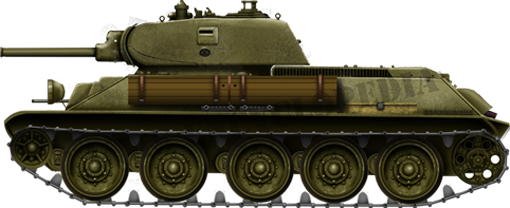
The 34/76 model 1940 was the first production version, largely derived from the previous A20 and T32 preseries. Hundreds of them were about to be put in service in july 1941, and around 150 were ready when operation barbarossa was launched. They performed well despite the lack of training of their crews and inept command, just like the KV-1s. Few Panzers can match them in single combat, but they were a only handful of them, largely spread in a gigantic front.
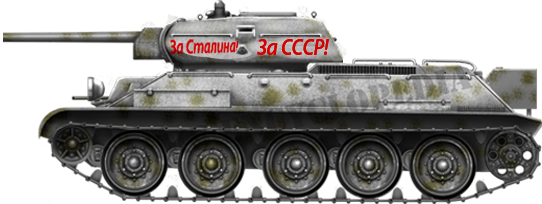
The 34/76 model 1941 was a cheaper and simpler production version of the 1940 model, with many improvements including most wielded elements, and a new two-piece cast turret, with a new wide hatch which became one of the striking caracteristic of the T34. Railing were added on the hulls, sometimes of a standard piece with two folds, or a more simpler version with a simple tube running all along the upper part of the sloped hull. T34s were used soon as improvised transportation devices in the hart of battle, mostly due to their impressive off-road capabilities, that few trucks could match at that time.
The 34/76 model 1942 not shown major improvements on the 1941 model, but only a handful of them received the new twin hatches which were dubbed by the Germans "mickey mouse", when opened. Mass production was the main goal of engineer which simplified many parts to lowering the cost and increase the rate of delivery. At Stalingrand ("tankograd"), T34 famously built at "red october" and "barricade" factories were thrown in battle a few hundred meters far, in a bare metal finish, without any kind of markings...
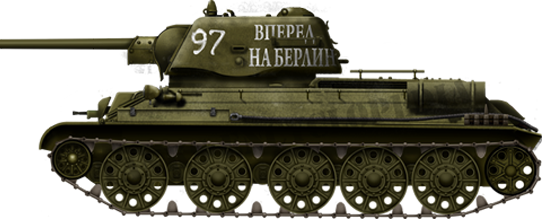 The 34/76 model 1943 received the new three-man turret with the twin hatch and better optics which greatly improved the efficience of the commander. At the fall of 1943, they all received the new commander cupola, which also improved greaty their visibilty on the battlefield. However, production standards were poor, and many tanks were lost due to mecanical breakdowns. The model 1944 was equipped systematically with the new turret, with a wider commander cupola, and limited extra armour. External equipments included spare tracks, tools boxes, fuel tanks, and improvised protections of all kinds, for example, entire pruned trunks, rails, scrap metal, and during the battle of Germany and especially in Berlin, an improvised Panzerfaust defence made of spring beds or various metal frames...
The 34/76 model 1943 received the new three-man turret with the twin hatch and better optics which greatly improved the efficience of the commander. At the fall of 1943, they all received the new commander cupola, which also improved greaty their visibilty on the battlefield. However, production standards were poor, and many tanks were lost due to mecanical breakdowns. The model 1944 was equipped systematically with the new turret, with a wider commander cupola, and limited extra armour. External equipments included spare tracks, tools boxes, fuel tanks, and improvised protections of all kinds, for example, entire pruned trunks, rails, scrap metal, and during the battle of Germany and especially in Berlin, an improvised Panzerfaust defence made of spring beds or various metal frames...
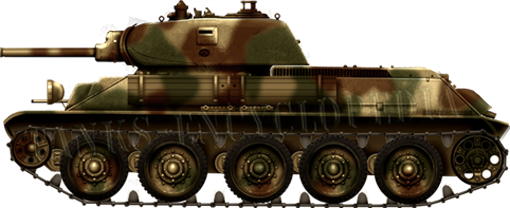
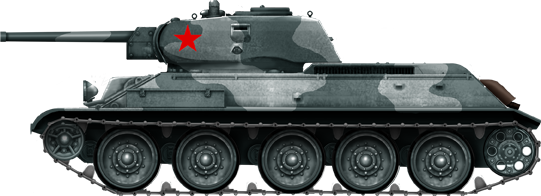
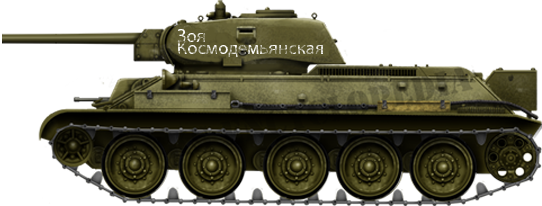
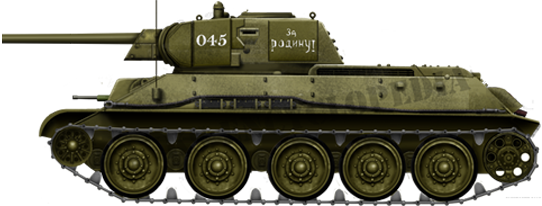
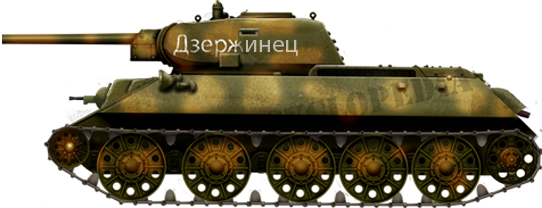
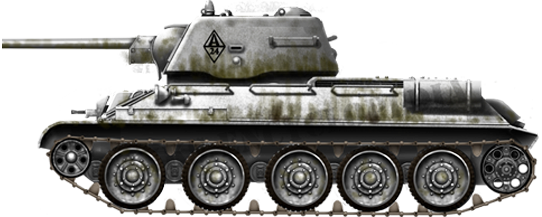
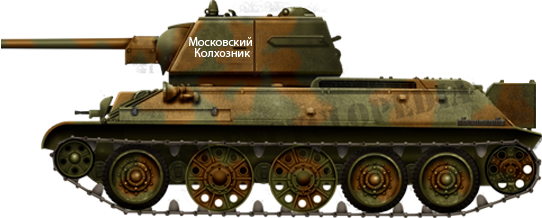
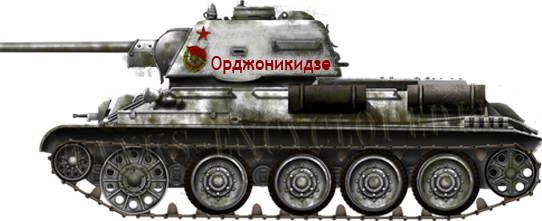
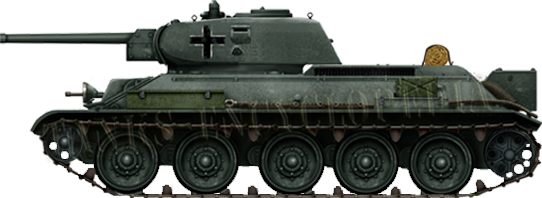
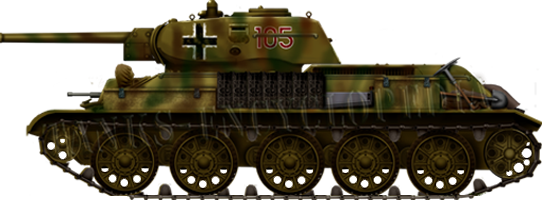
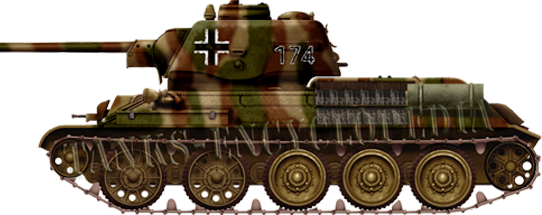

The T34 1940, the first mass production model. The 1941 has many differences, mostly turned towards an easier production.
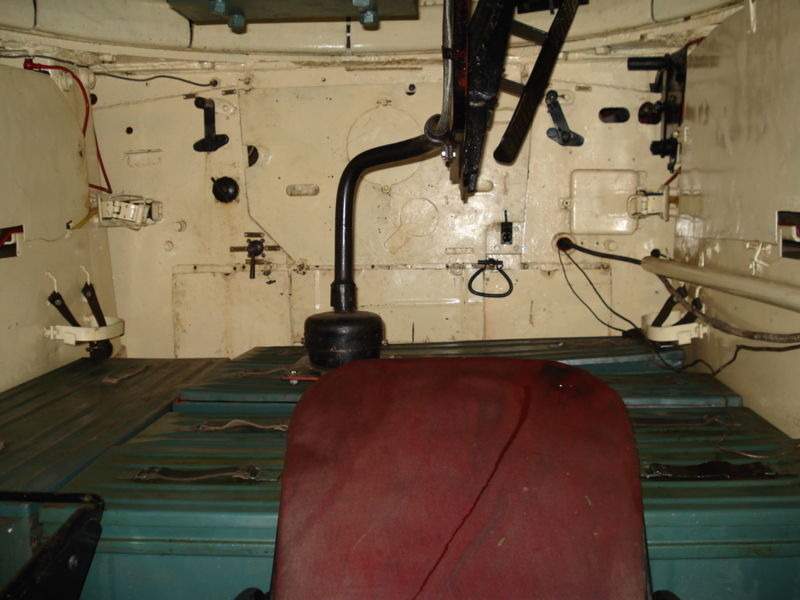
The T34 model 1941/42 interior. The floor were the commander stands is made of ammunition cases. The finishes and equipments were limited to the bare minimum.

Newly built T34 stocked on reinforced wagons, in a train directed to the frontline.
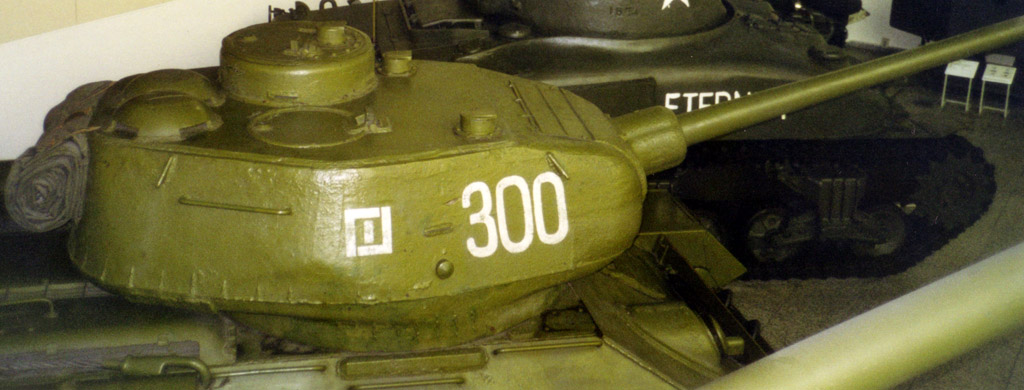
T34-85 massive turret. It was derived from the T34 model 1943 three man turret, fitted with a commander cupola.

A Polish T34-85 at Poznan museum. It was basically a T34 with the T43 turret and 85 mm gun.

The hull ZiS machine-gun.

One of the most common derivative of the T34 main components was the autopropelled guns and tank hunters Su-100 and Su-122.
Very first T-34 article, December 2011.

WW2 Tanks




























WW2 tanks posters

All Tiger tanks liveries.

Panther liveries and variants

WW2 Armour - All tanks











Tanks aces and single tanks series

Find more there

Museums, Movies, Books & Games
The Tanks and Armor in pop culture
Tanks and armored vehicles in general are only really grasped when seen first person: The mass, the scale, it's all there. Explore also the way tanks were covered in the movie industry, in books and in video games.Movies:
Best tanks movie on warhistoryonline.com
On imdb.com
On bestsimilar.com/
miltours.com
liveabout.com/
watchmojo.com
Video Games:
pcgamesn.com
historyhit.com
levvvel.com
vg247.com/best-tank-games
mmobomb.com/
alienwarearena.com

